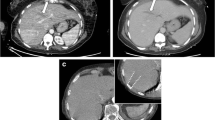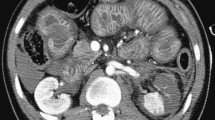Abstract
The CT scans of 400 consecutive children evaluated with CT following blunt abdominal trauma were evaluated to determine the frequency of periportal lowattenuation zones, assess patterns of associated intraabdominal injury, and examine clinical outcome. Periportal low-attenuation zones were noted in 60 children (15%). The presence of these zones was associated with a significantly higher incidence of intraabdominal injury (60% versus 11%,p=0.0001). Injuries most frequently associated with zones of periportal low-attenuation included hepatic (n=23,38%), and adrenal (n=14,23%). Children who had periportal low-attenuation zones tended to be more physiologically unstable as evidenced by a lower Trauma Score (diffuse, 11.9; focal, 13.4) than children without the zones (15.1,p=0.0001). The presence of these zones was also associated with a significantly higher mortality rate (13% versus 1%,p=0.0001). Ten children who had periportal low-attenuation zones and no hepatic injury on CT had a normal appearing liver on gross inspection at surgery or autopsy. In conclusion, periportal lowattenuation zones are common in children who have hepatic injury. These zones may be seen in conjunction with non-hepatic visceral injury or in the absence of intraabdominal injury. The presence of zones of periportal lowattenuation is associated with a higher index of physiologic instability, and higher mortality.
Similar content being viewed by others

References
Kaplan SB, Sumkin JH, Campbell WL, Zajko AB, Demetris AJ (1989) Periportal low-attenuation areas on CT: value as evidence of liver transplant rejection. AJR 152: 285
Wechsler RJ, Munoz SJ, Needleman L et al (1987) The periportal collar: a CT sign of liver transplant rejection. Radiology 165: 57
Koslin DB, Stanley RJ, Berland LL, Shin MS, Dalton SC (1988) Hepatic perivascular lymphedema: CT appearance. AJR 150: 111
Marincek B, Barbier PA, Becker CD, Mettler D, Ruchti C (1986) CT appearance of impaired lymphatic drainage in liver transplants. AJR 147: 519
Goldstein L, Mirvis SE, Kostrubiak IS, Turney SZ (1989) CT diagnosis of acute pericardial tamponade after blunt chest trauma. AJR 152: 739
Koslin BD, Stanley JR, Berland LL, Shin MS, Dalton SC (1988) Hepatic perivascular lymphedema: CT appearance. AJR 150: 111
Macrander SJ, Lawson TL, Foley WD, et al (1989) Periportal tracking in hepatic trauma: CT features. J Comput Assist Tomogr 13: 952–957
Cox JF, Friedman AC, Radecki PD, Lev-Toaff, Caroline DF (1990) Periportal lymphedema in trauma patients. AJR 154: 1124
Patrick LE, Ball TI, Atkinson GO, Winn KJ (1992) Pediatric blunt abdominal trauma: periportal tracking at CT. Radiology 183: 689
Siegel MJ, Herman TE (1992) Periportal low attenuation at CT in childhood. Radiology 183: 685
Champion HR, Sacco WJ, Camazzo AJ, Copes W, Fouty WJ (1981) Trauma score. Crit Care Med 9: 672
Eichelberger MR, Mangubat EA, Sacco WJ, Bowman LM, Lowenstein AD (1988) Outcome analysis of blunt injury in children. J Trauma 28: 1109
Sivit CJ, Taylor GA, Bulas DI et al (1992) Posttraumatic shock in children: CT findings associated with hemodynamic instability. Radiology 182: 723
Haftel AJ, Lev R, Mahour GH et al (1988) Abdominal CT scanning in pediatric blunt trauma. Ann Emerg Med 17: 684
Oldham KT, Guice KS, Ryckman F et al (1986) Blunt liver injury in childhood: evolution of therapy and current perspective. Surgery 100: 542
Sander P, Garramone RR, Schwartz RJ et al (1991) Evaluation of liver function tests in screening for intraabdominal injuries. Ann Emerg Med 20: 838
Author information
Authors and Affiliations
Rights and permissions
About this article
Cite this article
Sivit, C.J., Taylor, G.A., Eichelberger, M.R. et al. Significance of periportal low-attenuation zones following blunt trauma in children. Pediatr Radiol 23, 388–390 (1993). https://doi.org/10.1007/BF02011968
Received:
Accepted:
Issue Date:
DOI: https://doi.org/10.1007/BF02011968



